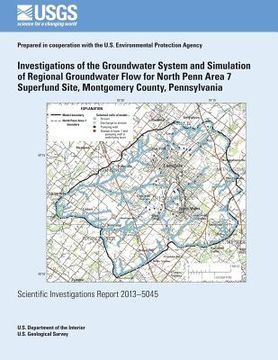Share
Investigations of the Groundwater System and Simulation of Regional Groundwater Flow for North Penn Area 7 Superfund Site, Montgomery County, Pennsylv (in English)
Daniel J. Goode
(Author)
·
Lisa A. Senior
(Author)
·
Createspace Independent Publishing Platform
· Paperback
Investigations of the Groundwater System and Simulation of Regional Groundwater Flow for North Penn Area 7 Superfund Site, Montgomery County, Pennsylv (in English) - Goode, Daniel J. ; Senior, Lisa A.
$ 15.99
$ 19.99
You save: $ 4.00
Choose the list to add your product or create one New List
✓ Product added successfully to the Wishlist.
Go to My WishlistsIt will be shipped from our warehouse between
Tuesday, July 09 and
Wednesday, July 10.
You will receive it anywhere in United States between 1 and 3 business days after shipment.
Synopsis "Investigations of the Groundwater System and Simulation of Regional Groundwater Flow for North Penn Area 7 Superfund Site, Montgomery County, Pennsylv (in English)"
Groundwater in the vicinity of several industrial facilities in Upper Gwynedd Township and vicinity, Montgomery County, in southeast Pennsylvania has been shown to be contaminated with volatile organic compounds (VOCs), the most common of which is the solvent trichloroethylene (TCE). The 2-square-mile area was placed on the National Priorities List as the North Penn Area 7 Superfund site by the U.S. Environmental Protection Agency (USEPA) in 1989. The U.S. Geological Survey (USGS) conducted geophysical logging, aquifer testing, and water-level monitoring, and measured streamflows in and near North Penn Area 7 from fall 2000 through fall 2006 in a technical assistance study for the USEPA to develop an understanding of the hydrogeologic framework in the area as part of the USEPA Remedial Investigation. In addition, the USGS developed a groundwater-flow computer model based on the hydrogeologic framework to simulate regional groundwater flow and to estimate directions of groundwater flow and pathways of groundwater contaminants. The study area is underlain by Triassic- and Jurassic-age sandstones and shales of the Lockatong Formation and Brunswick Group in the Mesozoic Newark Basin. Regionally, these rocks strike northeast and dip to the northwest. The sequence of rocks form a fractured-sedimentary-rock aquifer that acts as a set of confined to partially confined layers of differing permeabilities. Depth to competent bedrock typically is less than 20 ft below land surface. The aquifer layers are recharged locally by precipitation and discharge locally to streams. The general configuration of the potentiometric surface in the aquifer is similar to topography, except in areas affected by pumping. The headwaters of Wissahickon Creek are nearby, and the stream flows southwest, parallel to strike, to bisect North Penn Area 7. Groundwater is pumped in the vicinity of North Penn Area 7 for industrial use, public supply, and residential supply. Results of field investigations by USGS at the site and results from other studies support, and are consistent with, a conceptual model of a layered leaky aquifer where the dip of the beds has a strong control on hydraulic connections in the groundwater system. Connections within and (or) parallel to bedding tend to be greater than across bedding. Transmissivities of aquifer intervals isolated by packers ranged over three orders of magnitude [from about 2.8 to 2,290 square feet per day (ft2/d) or 0.26 to 213 square meters per day (m2/d)], did not appear to differ much by mapped geologic unit, but showed some relation to depth being relatively smaller in the shallowest and deepest intervals (0 to 50 ft and more than 250 ft below land surface, respectively) compared to the intermediate depth intervals (50 to 250 ft below land surface) tested. Transmissivities estimated from multiple-observation well aquifer tests ranged from about 700 to 2,300 ft2/d (65 to 214 m2/d). Results of chemical analyses of water from isolated intervals or monitoring wells open to short sections of the aquifer show vertical differences in concentrations; chloride and silica concentrations generally were greater in shallow intervals than in deeper intervals. Chloride concentrations greater than 100 milligrams per liter (mg/L), combined with distinctive chloride/bromide ratios, indicate a different source of chloride in the western part of North Penn Area 7 than elsewhere in the site.

